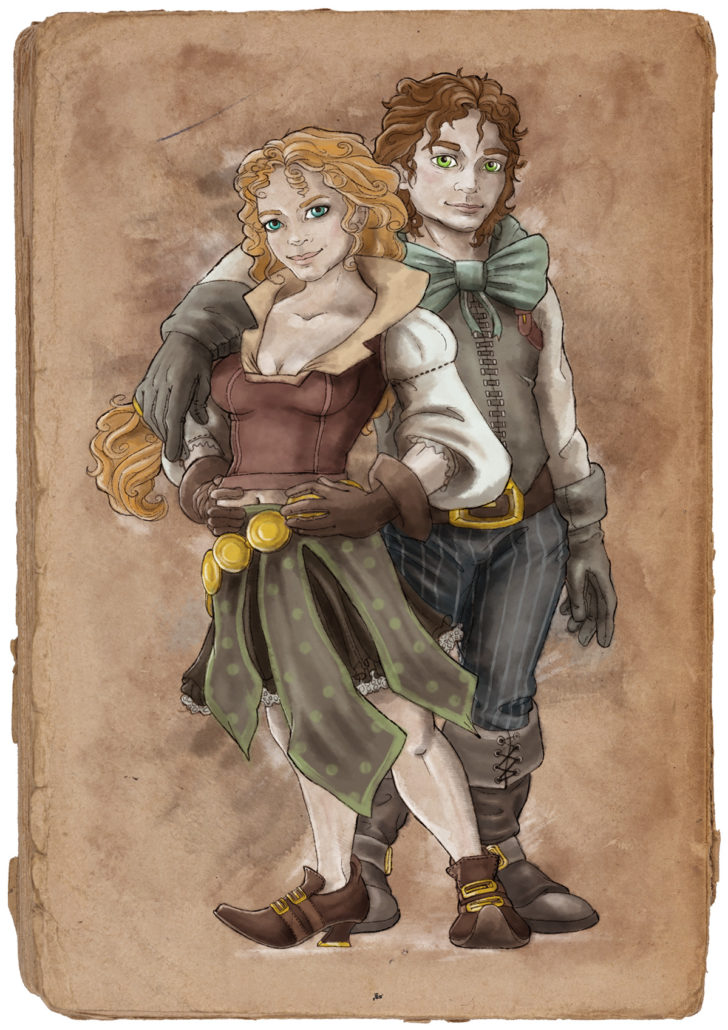Faeries
“The Faerie who joined us possessed black hair, rosy cheeks, and shimmering, keen eyes with pink irises. He wore a number of rings and a tunic of seagull flight feathers instead of the normal garb of leaves. I thought immediately he must be a mage of some kind, perhaps the witch doctor of this tribe. The Faerie sat. He clicked his fingers with one hand while taking a sip of tea with the other, and suddenly we could hear no sounds from beyond our carpet. It was as though a cake tray lid had clapped down over us.”
The smallest and most majikally inclined race may be divided into two constituents: those wild Faeries which remained on Tanzia after the Reign of Maraa, and the civilized Cavendian Faeries who have lived alongside men and integrated into one society under one law and government.
Appearance and Physical Characteristics
Faeries, on average, rise to the knee of an adult human. For their scale, they are generally plumper. They have skin as dazzling as pearl, and their irises may be any vibrant color of the rainbow. Though their hair is slightly shinier than a human’s, the rest of their physical features are comparable. Both Cavendian and wild Faeries lack the wings, pointed ears, and other fantastical additions with which Faeries love to fill their tall tales and folklore.
Clothing
The Faeries of Cavendia dress in the respectful and proper human fashion, though they have a great affinity for disproportionately huge cravats, cuffs, buttons, ascots, and neckties.
The Faeries of Tanzia wear garments sewn from leaves and other vegetation.
Language
It is considered educated, both on Tanzia and on Cavendia, for a Faerie to be bilingual. Of course, many city-dwelling Faeries speak the human language exclusively. On Tanzia, literature from before the time of the reign of Maraa is often in the Cavendian language, when it was an older form and widely spoken on the continent. Many Faeries study this as part of their basic schooling. It is considered a dead language but one of importance to Faerie history. The evolved Cavendian tongue is therefore easy for educated Faeries to understand, though terms coined by the inventors of the last century require explanation.
The Faerie tongue is generally considered to be more elegant, musical, and sophisticated than the human tongue.
Another curious element of the Faerie psyche is their unison laughter, which starts and stops simultaneously when they are in groups. This is generally attributed to their majikal nature, but this has not been proven.

Territory
Civilized Faeries live throughout all Cavendia in roughly the same distribution as men, according to the Tuttlebridge University Department of Geography.
On Tanzia, wild Faeries are known to inhabit the forests and jungles both south and east of the Hylu Mountains. They dominate the tropical forests northeast of the Sudd wetlands, north of the band of Interior jungles.
Culture and Technology
Faeries are, by a wide stretch, the most physically impotent of the reasoning beings. Many objects such as firewood, fallen game animals, lanterns and such, which are easily carried by humans, are too heavy for Faerie-kind. Their disadvantage of physical strength is made worse by the fact that they consume portions of food equal to what would sate a man. They are, however, exceptionally gifted in majik. This balances any evolutionary disadvantages they might have in the muscles.
Faerie majik is not decisive majik — the kind humans were banned from using by Altaican law. With crystals, with majikal implements such as wands, with scrawling, with incantation, with majikal song, and other facets of the arcane, Faeries can see to their farm work, to the raising of livestock, to hunting, and even to warfare, for their soldiers are really mages rather than any sort of knight.
Not only do they best humans in the knowledge and applications of majik, but they also possess two skills which appear to be one of Faerie-kind’s unique strengths: potion-making and enchanting.
On Tanzia, Faeries tend to live in forest clearings majikally protected from the elements and danger by unseen barriers. They dwell in homes or longhouses made of wood and roofed with wooden shingles, which they allow moss to grow on. Sometimes field stones and rocks from jungle rivers are used to construct more complicated abodes or chimneys, which are built crooked by design. Tents or awnings of brightly colored cloth are often stretched between stumps, fallen logs, homes, or trees for additional shelter or merchant space.
Special Topic: Cooking & Baking
“But what rose above all this was their baking. There were cakes, bon bons, tarts, truffles, muffins, strudels, fudge, baked toast, petit fours, eclairs, divinity, sweet breads, flat breads, milk bread, quiches, coffee cake, and – my favorites to be sure – treacle and crackle. It is no wonder Cavendian Faeries are so partial to sweets.”
While not majikal in itself (even if some majik is used to facilitate the process), the Faerie culinary arts are profound and unique. Their extensive base of techniques, processes, and recipes are owed to lifetimes of accurate recording of culinary experimentation, a labor indicative of their appreciation of eating. Their use of such a wide variety of ingredients and food sources is owed no doubt in some part to their wide geographic distribution in all types of forest, including rainforests.
Their emphasis on cooking, drinking, and entertaining befits a people regarded as inherently pacifistic and peaceful. Faeries appreciate art, beauty, and craftsmanship, avoiding conflict wherever possible.
